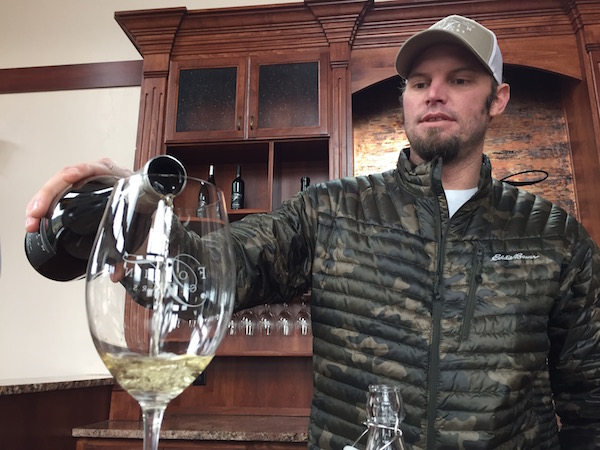
GOLD HILL, Ore. – There’s not much pretense, but there’s a wealth of overlooked winemaking talent in Southern Oregon’s Rogue Valley, and the unpretentious Rob Folin of Folin Cellars serves as an example of both.
Not many winemakers will wear a camouflage jacket in their tasting room, but it fits Folin. And only a select few can say they worked at prestigious Domaine Serene – one of the Willamette Valley’s most high-profile Pinot Noir houses.
“My winemaking started at Domaine Serene, and I was just going to school and working and drinking – drinking a lot,” Folin told Great Northwest Wine. “I’ve always tried to remember at least one thing from every wine I’ve tried, no matter where I’m at.
“And if you find something that you like, try to carry that into your winemaking. And if you don’t know how, then ask. I’m not worried one bit about looking stupid,” he added. “If somebody else has already done the legwork, then why do I have to reinvent it?”
Folin – pronounced FOAL-lynn – operates two tasting rooms, the winery and vineyard with his folks, Scott and Loraine. They oversee 25 acres of vines, a production of 1,500 cases, and an estate tasting room about 10 miles north of Medford and as well as their north Willamette Valley tasting room in downtown Carlton. The tasting room at their Sam’s Valley estate is a filled with granite and features a 20-foot ceiling that leads to a gravity-flow production facility and a library cellar for club members.
“The idea was to have you be surprised when you come in,” Folin said. “When you drive around rural Oregon, sometimes it can be kind of creepy – like you want to have an escape route. Around here, if you hit a gravel road, you should probably stop and re-think about where you are going.
“We have the stucco coming in and it’s kind of California-like,” he added. “So if you’ve been to California wineries, it might be something you would be familiar with, but not having any of the turning your nose up at people. Have it be more Oregon-like – just very nice. Even if you don’t know anything about wine? Great, we’ll teach you something here.”
We caught up with Folin earlier this year in Sam’s Valley as part of the Oregon Tempranillo Celebration in the Rogue Valley.
Here’s the interview:
[powerpress]
Folin Cellars shines with Rhône grapes, Tempranillo
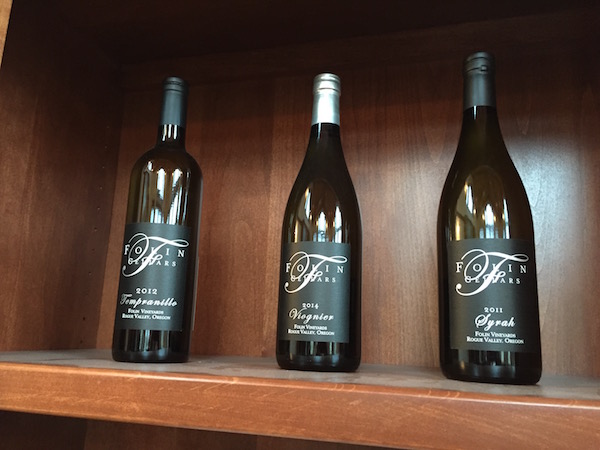
Folin seems a bit uncomfortable behind the tasting bar, and it’s probably not a good idea to ask him to handle a transaction.
“I’m very uncool with computers, and I don’t understand any of the social media stuff. I’m horrible at it,” he said. “I just finally got my Facebook thing going three days ago.”
In the cellar, he’s an obvious fit.
The family has followed the lead of Southern Oregon icon Abacela in planting Tempranillo, and Folin Cellars also continues to distinguish itself with Rhône varieties – Grenache, Mourvèdre, Petite Sirah, Syrah and Viognier.
Earlier this year, the Folin Cellars 2012 Estate Grenache and Misceo GSM both earned Great Northwest Wine’s top rating of “Outstanding!” And his touch extends beyond Rhône varieties, evidenced by the double gold at the San Francisco Chronicle Wine Competition in January for his 2012 Estate Tempranillo.
“Everyone in Oregon, in general, is pretty willing to help out, maybe until you are super big,” Folin said. “Maybe nobody will help you then, but by then, it doesn’t matter. We’re not there yet, though.”
Dundee Hills back to Sam’s Valley
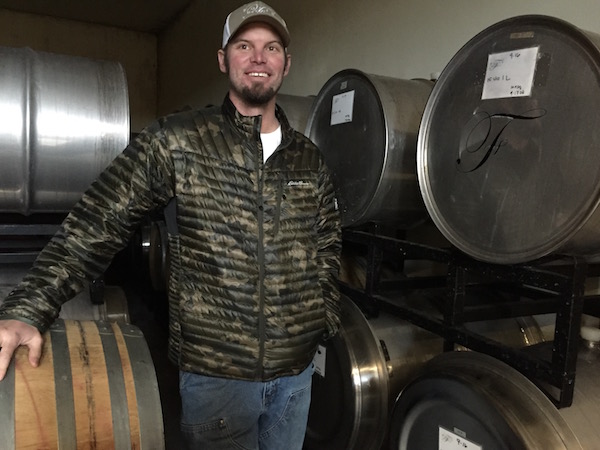
As his family was planting its first wine grapes, Folin decided to take a wine appreciation class at Chemeketa Community College from beloved instructor Bob Sogge.
“That’s what got me hooked,” Folin said. “He was an older guy and just the nicest guy. He’d bring in wines from his cellar that were made before I was even born. It was amazing. That made me enjoy the industry as a whole.”
Folin used a bit of chicanery to land his first winery job in 2001, getting in on the ground floor of what’s become one of the West Coast’s showpiece wineries: Domaine Serene. The Evenstads launched their brand in 1990 and were poised to make a huge splash with their estate atop the Dundee Hills.
“They were still down in Carlton,” Folin said. “I saw one of those fliers with the little tags on it for an intern job, and I tore the whole thing down because I didn’t want anybody else to get it. There was already one pulled off, and I thought, ‘Man, I’ve already lost my chance.’
“I ended up working with that guy,” he added. “That was (the Evenstads’) first harvest at their new facility. I’m not sure how much that place cost to build. $50 million? I don’t know. That place was crazy.”
Folin worked for acclaimed winemaker Tony Rynders during those days at Domaine Serene, leaving the employment of the Evenstads after the 2007 harvest and ready for day-to-day work on his family winery.
“It was really interesting to learn how to make wine when you have the biggest wallet you can imagine,” Folin said. “If you wanted something, you got it.”
Transitioning from citrus to Viognier

Along the way, the Folin family – who had farmed citrus and avocados in Southern California – started its vineyards by planting Viognier in 2001. (Prior to that was an ill-fated baby kiwi experiment.) Their label debuted with the 2005 vintage, and his family built the tasting room/winery in 2009.
“We made those wines in the Willamette Valley at different wineries – wherever we could get space,” he said. “I was working at Domaine Serene and wasn’t allowed to make my wines there. The only way I got away with it was I said it was my parents who were doing it.”
Those days with Rynders at Domaine Serene proved invaluable. It allowed him insight into vineyard sourcing, yeast strains, cooperages and winemaking techniques that most will only dream of.
“I built up this winemaking style in my head of what I like,” Folin said. “I was like the little kid you just want to shut up because they keep asking questions. Why? Why? Why? Eventually, it was, ‘Go away. Go clean something.’ ”
Folin does make Hayward by Folin Cellars – small lots that include a Pinot Noir project with the 2013 vintage featuring Utopia Vineyard in the tiny Ribbon Ridge American Viticultural Area. Pouring those wines in Carlton has proven to be a nice fit for Folin Cellars, and it opened that Willamette Valley tasting room several years ahead of its Southern Oregon facility.
“Everyone tastes all the Pinots they can fit into the day, and by the end of the day they are just finished with Pinots,” Folin said. “They come to our place and try Tempranillos and Syrahs at half the price.
“People will say, ‘Can I trade this case of whatever I bought for two cases of yours?’ And I’ll tell them, ‘No! You should have come here first.’ ”
Carlton continues to be a success venture for Folin Cellars.
“It gives us a consumer base in the Portland area that doesn’t have to drive four hours down the freeway to get here to buy our wines or pay $30 to ship their wine,” he said. “And every year, we’ll still get a good portion of people who went to the Carlton tasting room and tell us, ‘We love the wine and wanted to come down here and see what it’s about.’ That’s a lifetime consumer because they get the whole experience.”
Devoted to Vino-Seal
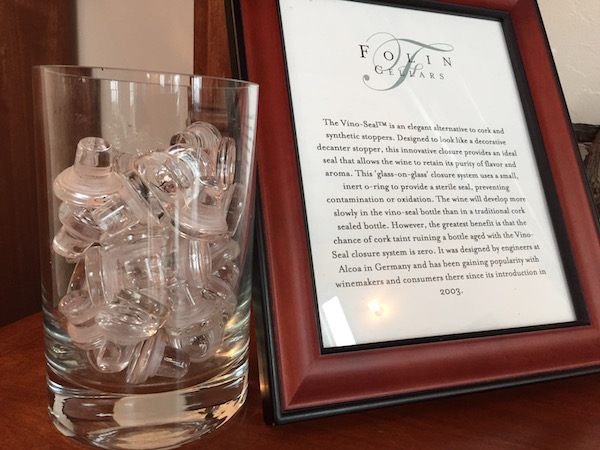
Another way in which Folin Cellars stands out in both the Willamette Valley and the Rogue Valley is its embrace of Vino-Seal, the glass closure with a plastic liner developed by Alcoa.
“We were one of the first people to use it, beginning with the ’05 vintage,” Folin said. “I think Sineann was using them and in California there was Whitehall Lane. They’ve been so awesome for us. I think there’s been one bad bottle since we started, and it was because it didn’t have the seal. You are talking about a pretty good rate.
“If screw caps weren’t still so negatively looked at, I’d go that way because they are way cheaper,” he said.
Folin, who labels himself an introvert, appreciates what the Vino-Seal adds to the dining table.
“It’s a conversation starter, so that’s a benefit right there,” he said. “They are definitely expensive, and you’ve got just two bottle shapes – a Burgundy and a Bordeaux. In my opinion, anything that limits the marketing people’s ideas is always good.”
And the minimal amount of air exchange after bottling allows Folin some freedom as a winemaker.
“You need to be a little more aggressive about getting air into the wine before you bottle,” he said. “Instead of spending money gassing down a tank and be really gentle moving the wine, you just use a pump and crank it up and get air to it. I don’t sparge the bottles before. I want the wine to get that air right before bottling and create that little 750-milliliter time capsule.”
For the first five years, Folin and his team had to apply the Vino-Seal by hand. That changed in 2010.
“The manufacturer came up with a dispenser that hooks up to the normal bottling line,” he said. “Now I don’t have to watch my dad putting them on one at a time.”
Folin Cellars finds its identity
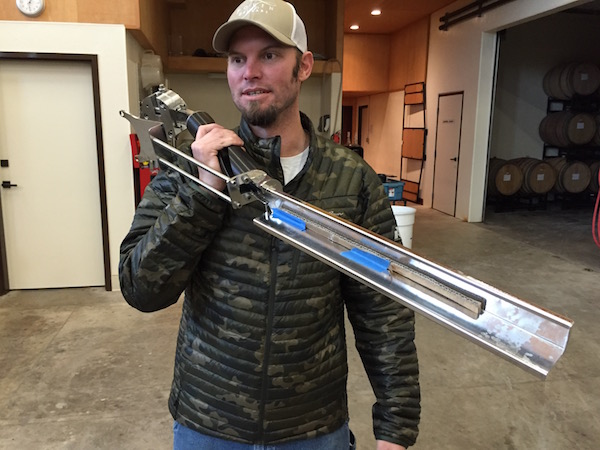
For the most part, the move from Southern California orchards to Southern Oregon in the 1990s seems to have been much more positive than negative for Folin and his family.
“I still can’t buy an avocado at a store,” he said. “They are just gross. I can’t tell you how many thousands of dollars of avocados I threw at my brother growing up. We had avocado fights, and it blows my mind to see them for $2 at the store. The oranges that make it here are horrible, and I miss the grapefruit, but I don’t miss anything else about California. Too many people and the schools were bad.”
He’s especially bullish on Grenache, but he’s given up on chasing its Rhône relative Petite Sirah.
“I think we’ve finally figured out in Southern Oregon to stop trying to make California wines,” Folin said. “We cannot do it. I always wanted make Petite Sirah – a least a barrel of it – overripe, just this humongous wine and try to get it pruny because apparently that’s a great wine. It sells like crazy, but it’s not physically possible to grow that here. That was my head’s up.”
That experiment didn’t fail for lack of attention. He couldn’t offer a hobby other than fly-fishing, and much of the time he spends away from Folin Cellars is shared with his wife and their two young daughters.
“Honestly, I like to work,” he said. “I even enjoy being in the tasting room once in awhile. And I do like to drink anything – again that’s another learning experience.”
Just don’t ask him to crunch the numbers on what it takes to launch a winery.
“I remember doing some really fuzzy math of ‘This many tons will equal this many bottles of wine at $30 a bottle,’ ” Folin said. “ ‘Holy crap, we’re going to make $2 million a year!
“Somehow, it ended up being more like $2,000 a year,” he laughed. “There must have been a decimal point that was off. We’re slowing working that one out. Like most grape farmers, you are not going to make that much money just farming, but if you vertically integrate, you have more of a chance.”

Leave a Reply